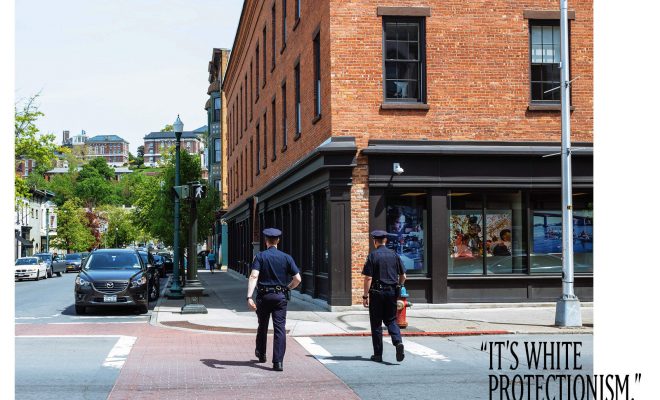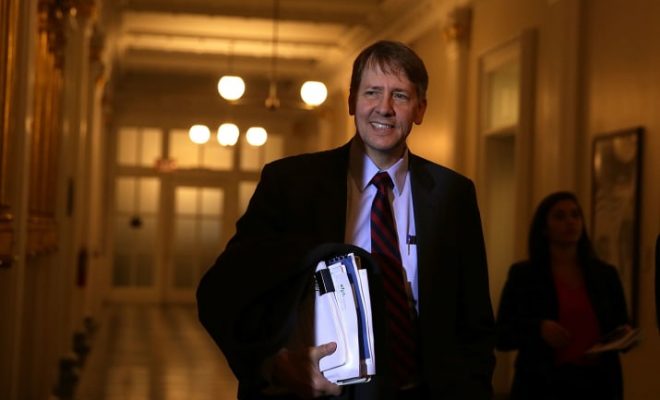Police Forces Are Sending A Message To Black Suburban Residents: You’re Not Wanted

Places like Troy used to be lily-white, and most of their police departments still are. That’s a problem for the black and brown people moving from big cities like LA and New York in search of quieter places to raise families.
It started with a noise complaint. Don Hansbury, who is 78 years old and white, went to the doorway of his home in Troy, New York, that August night in 2013 to see what was going on. “Cop was talking to a guy with loud music playing from his car, colored guy,” he said. “I knew something was gonna happen.”
The cop was talking to Hansbury’s across-the-street neighbor, Sam Ratley, who is 39 years old and black. Soon, Hansbury heard “some kind of scuffle,” and then police cars filled the block. After a few minutes, Ratley and two other black men were led away in handcuffs. Though Hansbury didn’t see what happened, he said, “I just knew that guy beat up the cop.”
That was the story in the police report, conveyed in the local newspaper the next day. According to police, Ratley refused to turn his music down and when Officers Dominick Comitale and Brandon Cipperly began to handcuff him, a crowd gathered and attacked the cops. Ratley and two others were charged with resisting arrest and assaulting a police officer.
Jurors didn’t buy that story. They acquitted Ratley, who testified that Officer Comitale had pulled up outside his home and immediately begun cursing at Ratley as he sat on his porch with some friends and relatives. When the group got up to go inside, Ratley said, the officer shoved him against the building and kneed him in the face and chest. Ratley sued the department and received a $60,000 settlement last year.
It was a familiar story in Troy — where, over the last six years, at least seven black residents have been acquitted of resisting arrest and then paid by the city over claims of police brutality — and evidence of a nationwide trend driven by demographic shifts shaking the country. As black and brown people leave major cities to raise families in areas that were once predominantly white, they’re encountering police departments that are slow to reflect those population shifts and all too eager to placate longtime white residents who equate change with rising crime. To those white residents, the officers serve as a final line of defense against the outsiders marching onto their land, uniformed allies paid to protect them from the dangers they feel closing in around them.
A Rust Belt city of 50,000 about 150 miles north of Manhattan, Troy, 92% white in 1980, is barely two-thirds white today, a transformation sweeping suburbs and small cities as a result of old barriers of enforced segregation dissolving, opening new lanes of migration. From 2000 to 2010, the black population declined by a total of nearly 300,000 people in the US’s four biggest cities: New York, Los Angeles, Chicago, and Houston; Atlanta’s black population dropped by 30,000. This dispersal, combined with a fast-growing Latino population, has turned formerly all-white places into merely majority white places — and formerly majority white places into places where whites are outnumbered by people of color: Of the US’s 100 biggest metropolitan areas in 1990, 25 cities and 5 suburbs were majority black, Latino, and Asian; by 2010, that had increased to 58 cities and 16 suburbs.
From 2000 to 2010, the number of black residents in Troy grew by 46%. Yet the police force remains 95% white, with just four black and two Latino officers on a staff of 120 — a common proportion in these quickly changing cities. In Balch Springs, Texas, where last month a white police officer responding to a complaint about underage drinking shot and killed 15-year-old Jordan Edwards, the police force remains nearly all white even as the city’s white population has drastically declined, from 63% in 2000 to 51% in 2010 and likely even lower today.
The result is a combustible mix: a white population anxious about its new black neighbors, and a white police force unprepared and ill-equipped to handle the thickening racial tensions.
“It’s white protectionism,” said Seth Stoughton, a former police officer in Florida who is now a law professor at the University of South Carolina. “When that element of otherness invades our community, it’s very easy to react as if we are being threatened, and to be fearful. And we react by calling the police.”
In 2011, the city of Antioch, California, where the white population declined from 65% in 2000 to 49% in 2010, settled a class-action lawsuit filed by black residents who accused the police department of racial discrimination. In 2016, locals filed a lawsuit against 13 suburban counties outside St. Louis, whose combined white population dropped by more than 30% from 2000 to 2010, accusing the towns of “extorting money” from black people through discriminatory traffic stops.
The most famous recent example of the consequences of white protectionism is Ferguson, Missouri, where the population transformed from 99% white in 1970 to less than 30% in 2010. The Justice Department, investigating the city after the fatal police shooting of Michael Brown in 2014, discovered that 93% of those arrested over a two-year-stretch were black. The police department that year was 94% white.
Within the last decade, the Justice Department found evidence of racial bias by law enforcement in at least eight other cities and counties with rapidly growing minority populations in New York, Connecticut, North Carolina, and Mississippi. Similar investigations seem unlikely under Attorney General Jeff Sessions, who has made clear his belief that the DOJ should not aggressively push for changes in local law enforcement agencies.
In Troy, black residents say police harassment and racial profiling are an everyday fact of life — and seem to be increasing. Black people, though just 16% of the population, made up 39% of those arrested in 2010, then 51% in 2016, according to a BuzzFeed News analysis of the department’s arrest records. In 2016, 90% of minors arrested for marijuana possession were black, up from 56% in 2010.
“It’s a constant picking on the people in those communities,” said Bob Fitzgerald, a longtime Troy police officer who served as union boss for 12 years before retiring in 2014. “That was all we knew. If you were to see a black male on the street corner, or a group, unfortunately the thought there was ‘Oh my god, somebody must be dealing drugs.’ They were like a magnet to the police department.”
To many black residents, the police department seems to be passing along a message from their white neighbors: You’re not welcome here.








